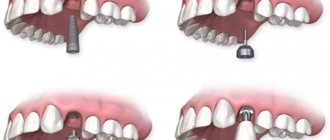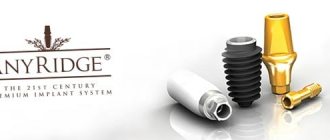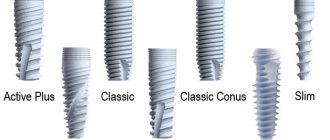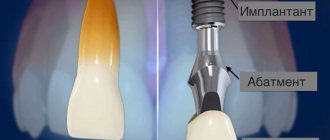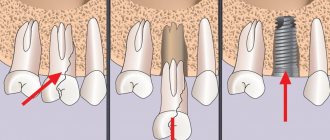Duration of engraftment Causes of rejection Signs of rejection Contraindications to implantation Types of implantation Engraftment above and below What to do with mobility?
Care after surgery Implantation is the only prosthetic method that restores the functionality of the entire tooth, and not just its crown part. A dental implant is a multicomponent structure made of biocompatible material (titanium and its alloys), introduced into the jaw bone to replace a missing tooth unit. It fully replaces a natural tooth, taking over all its functions. Those who decide to undergo implantation are usually interested in how dental implants take root, how long it will take, and what problems may arise.
The viability of an artificial root depends not only on the choice of its type, shape, and size according to the parameters of the jaw bone. But also on the general state of health, correct installation of the implant, compliance with the doctor’s instructions in the postoperative period.
How long do dental implants take to take root?
The process of fusion of an implant with bone is called osseointegration. It goes like this:
- In the first 30 days
after the introduction of the artificial root, trabeculae of spongy substance begin to actively form around it, forming the skeleton of bone tissue. During this period, the tissue around the implant is soft, loose, and easily injured. - about 3 months
, a soft, loose spongy structure forms into dense lamellar bone, firmly holding the titanium root. During this period, the implant can already be loaded with a prosthesis. - Complete fusion with the jaw bone occurs after 1.5 years
.
The survival rate of dental implants is influenced by various factors - from the implantation protocol used to the type of jaw the structure is integrated into (lower or upper). After implantation, enough time must pass for the bone tissue to “accept” the artificial root and begin to grow around it, ensuring a stable, strong fixation.
Dental implants – what are they?
Dental implants, implants, implants are all artificial structures that replace missing teeth. They are firmly fixed in the bone tissue of the jaw and serve as a reliable support for fixed or removable dentures in the form of single crowns and bridges of varying lengths (you can see what dental implants look like in the photo above). There are several types of dental implants, but the most popular today are root-shaped dental implants, which have earned favorable reviews from both patients and leading implantologists around the world. Prices for dental implants depend on their quality, features of the installation system, the presence of special coating and other factors. Which implants are better is a topic for a separate article.
Why an implant may not take root
The worst thing that frightens patients is the risk of rejection of the structure. Thanks to modern protocols and materials, the implant survival rate is as high as possible ( 97-98%
). When installing original implant systems Astra Tech, Nobel Biocare, ROOTT, Straumann, rejection rates do not exceed 0.2-0.5%, that is, the survival rate is almost one hundred percent.
When asked why dental implants do not take root, the doctor will answer after examination and diagnosis. But the patient needs to be more careful, not ignore warning signs, and immediately contact an implantologist. The success of the operation and engraftment is influenced by:
- health status;
- quality of preparation for surgery;
- choice of implants;
- implantation protocol;
- correctly calculated prosthesis design;
- careful adherence to medical recommendations in the postoperative period.
Attention to all of the above points reduces the likelihood of design rejection to zero. Typically, engraftment of a titanium root with classic two-stage implantation takes at least 3 months
. After the structure has fused with the bone, an abutment is fixed on them, and an artificial crown or prosthesis is placed on top. With express implantation or basal complex, engraftment proceeds faster. The implanted roots are loaded with a temporary prosthesis 1-3 days after surgery.
Caring for Dental Implants
Many patients who have had artificial teeth installed are concerned about the question: how to care for dental implants? In fact, caring for artificial teeth is practically no different from regular oral hygiene. The same few basic rules apply here: regularity, thoroughness, correctness. That is, you need to brush your teeth at least twice a day - in the morning and before bed, and preferably after every meal, especially after eating carbohydrates; this must be done for at least three minutes, and also use additional hygiene products: dental floss, irrigator, etc.; You need to brush your teeth correctly - with sweeping movements away from the gums. The same brushes that are used for cleaning natural teeth are suitable for cleaning dental implants, but you can purchase a special toothbrush for implants.
Main reasons for rejection
- Peri-implantitis
- the tissues around the implant become inflamed for various reasons: due to undetected contraindications to implantation, poor preparation of the oral cavity for surgery (untreated caries, active gum disease, etc.), violations of the installation protocol, failure to comply with medical instructions after surgery . - Features of the structure of the jawbone
- in loose, porous bone, even with sufficient volume, the titanium structure will not hold. To avoid problems, the bone is additionally strengthened with special materials. - Intolerance to the implant material
- although titanium and its alloys are biocompatible with bone structures, allergies sometimes develop. This usually happens if implantation systems of dubious quality that contain various harmful impurities are used. - Systemic diseases
- endocrine, immune, cardiovascular pathologies, oncological processes significantly increase the risk of artificial root rejection. - Incorrect osseointegration
- when installing low-quality systems, their components come into contact with the jaw structures and provoke the formation of fibrous tissue rather than bone. As a result, instead of strong bone tissue, a connective tissue capsule is formed around the implant, which cannot hold the structure, and it falls out.
The network of RUTT clinics in Moscow uses reliable, proven implantation systems. Before surgery, patients undergo a comprehensive examination to assess the characteristics of the dental system and contraindications. Implantation is performed after all risks have been eliminated, so the listed points are kept to a minimum.
How to protect yourself from possible problems in advance?
All the reasons for implant rejection are well known to specialists, which means that the problem can be prevented. It is for this purpose that a thorough examination of the patient is carried out, concomitant diseases and contraindications to surgery are identified.
Here are some useful tips to help minimize potential problems associated with implant failure:
- You need to realize that responsibility for the results of implantation lies not only with the doctor, but also with the patient (failure to follow the specialist’s instructions can ruin the result of even a perfectly performed operation).
- You should choose a clinic specializing in implantology - such centers invest enough money in modern equipment and professional training of employees.
- It is worth contacting those specialists who have sufficient experience and have positive recommendations and reviews from former patients.
- You need to choose high-quality implants from well-known manufacturers.
- It is necessary to scrupulously follow all the implantologist’s instructions after the intervention and carefully monitor oral hygiene.
- You need to monitor your health and keep chronic diseases under control (especially HIV, diabetes and other pathologies that affect the regenerative abilities of tissues).
Of course, some moments are simply impossible to predict. But we must remember that implant rejection is isolated cases, not a pattern.
Signs of implant failure
Swelling, pain, slight fever, bleeding gums 3-5 days after implantation
– a normal reaction to intervention. Within a week, these symptoms disappear. If symptoms persist longer than the specified time and increase, you should immediately contact an implantologist.
Signs of peri-implantitis on x-ray
Signs of rejection may appear not only during the rehabilitation period, but also later. How to understand that the implant is not taking root:
- severe swelling, hyperemia of the mucous membrane, persisting longer than 5 days after the intervention;
- acute pain, aggravated by pressure on the gum;
- the appearance of a bad odor;
- purulent discharge;
- bleeding for more than 2 days, ichor for more than 7 days;
- temperature 38°C and above, not reduced by antipyretics;
- implant mobility, its loss.
Sometimes there are no visual signs of rejection, the artificial root simply falls out. As a rule, if the implanted root has not been rejected within a month, osseointegration proceeds normally. But it happens when the artificial root is rejected at a later stage, after the installation of the prosthesis. The causes may be previous viral diseases, acquired after implantation, immune diseases, or injuries.
Conditions for successful osseointegration
“Engraftment” of implants has a greater chance of successful completion if:
- the operation is carefully prepared and planned;
- the patient is healthy and has no contraindications to the installation of implants;
- the dentist correctly chooses the method and method of performing this surgical procedure;
- High-quality implants from a trusted manufacturer are used for installation;
- the orthopedic stage proceeds without complications;
- the patient follows all recommendations of dentists, especially immediately after installation of an artificial root.
Contraindications to implantation
Contraindications to the procedure are divided into absolute and relative. Absolute conditions in which the operation is impossible include:
- oncology in the active phase;
- diabetes mellitus in the decompensated stage;
- mental disorders;
- acute tuberculosis;
- blood clotting pathologies;
- severe cardiovascular pathologies;
- a heart attack or stroke suffered less than 6 months ago;
- allergy to anesthetics, implant material;
- connective tissue diseases.
Relative restrictions:
- age under 18 years;
- poor oral hygiene;
- bad habits (alcoholism, smoking abuse);
- pregnancy, actuation;
- systemic diseases during exacerbation;
- infectious and inflammatory processes.
The ability to combine installation protocols significantly reduces the list of contraindications, allowing you to solve almost any clinical problem. One-stage protocols make it possible to carry out implantation in patients with HIV, periodontitis, periodontal disease, endocrine pathologies, hepatitis B, C, and other complex diseases that were previously considered an absolute contraindication to implantation.
Patients with periodontal pathologies are interested in the question of whether implants survive periodontal disease.
. One-stage protocols combine different models of implants (compression, basal). They have high rates of resistance immediately after surgery. Basal models are installed not in spongy bone, but in deeper bone sections - basal, bicortical, not subject to atrophy. The inclined position increases the area of contact between the implants and the bone and accelerates osseointegration.
Primary stability
In our center, the engraftment (in scientific terms - stability) of the implant is checked using a special Osstell ISQ device a few days after the procedure. This helps eliminate the possibility of early implant rejection, and if this begins, promptly replace the artificial root.
The point of the procedure is to register resonant electromagnetic oscillations of the implant and surrounding bone when exposed to an electromagnetic field through a magnetized pin. Simply put, a signal from the device’s magnet is applied to a pin screwed to a titanium root. The implant begins to oscillate, and the force of these oscillations is taken as the implant stability coefficient (ISI). The range of KSI is from 1 to 100, and the higher the value, the better the stability of the implant. The acceptable range starts at 58 KSI units for the maxilla and 66 units for the mandible. 3-6 months after surgery, these indicators are on average 61 and 65 units, respectively.
Unfortunately, such a device is not available in all clinics where implantation is performed, and doctors often check the implant’s survival the old-fashioned way: if there are symptoms, then something is wrong. And the danger lies in the fact that if re-implantitis is not detected in the early stages, the alteration will cost both additional money and additional health.
If one of the four implants does not take root at all, then it is unscrewed and replaced with another artificial root. As a rule, this procedure is carried out at the clinic’s expense, but it is a good idea to clarify before treatment whether this is true or not.
How long does it take for an implant to take root?
Osseointegration is influenced by the type of implantation system (type, shape, coating, type of thread, connection to the abutment), and the method of its installation. The doctor chooses the type of implants and implantation method according to the clinical picture. One- and two-stage technologies are used:
- Classical implantation (two-stage protocol) – two-component, root-shaped models are used. The root part of the implant is installed in the jaw, closed with a plug and sutured. After osseointegration of the titanium structure with the bone, the abutment and crown are fixed. Engraftment lasts 2-4 months (how the body reacts).
- One-stage methods with immediate loading - the prosthesis is attached to the implants after implantation (within 72 hours). Instant loading with the prosthesis stimulates bone formation around the implant, reducing the time of osseointegration. In the protocol, one-component models are more often used, in which the root-shaped part and the abutment form a single whole.
- Single-stage implantation - a titanium root is installed in the tooth socket immediately after its removal. The blood clot triggers the synthesis of osteoblasts, which accelerates engraftment. But this method is possible if there is sufficient volume and quality of the jaw bone, and the absence of even the slightest signs of inflammation. The implant is loaded with a prosthesis after complete engraftment.
With single-stage implantation, it is possible to install a temporary crown immediately after implantation
. But in this case, the structure is removed from the chewing process (the crown is made in height below the general row of teeth).
Dependence of the duration of the healing period on the location of the implants
How long do dental implants take to take root in the upper and lower jaws? The location of titanium roots plays a fairly important role in the duration of the healing period, so dentists very often have to answer the following questions:
- How long does it take for an implant to take root in the upper jaw? Usually 4-6 months. It takes a long time for a dental implant to take root in the upper jaw due to the fact that it is less supplied with blood and has a fragile structure. The proximity of the maxillary sinuses is also of no small importance, since they can cause the development of complications that prolong the engraftment period.
- How long does it take for an implant to take root in the lower jaw? The engraftment process lasts no more than 2-3 months. The reason for this lies in the high density of bone tissue, the lower one in which it is much easier for an artificial root to take hold and a good supply of blood to the lower jaw.
Deputy Chief physician Sergey Evgenievich Brodsky
Sign up for a free consultation
+7
Just CALL US!
+7
We will answer any of your questions and will definitely help you!
What to do if the implant is mobile and does not take root
If any sign of rejection appears, you should contact the implantologist who performed the operation. Based on the diagnostic results, it will be clear whether the implant can be saved with conservative therapy or whether it will need to be removed. In most situations, after eliminating the inflammatory process and restoring the jaw tissue, re-installation of the implant is possible. In the absence of contraindications, reinstallation is carried out after 1-2 months. If the bone tissue is severely damaged due to rejection, surgery to build it up will first be required.
Expert opinion
Igor Yurievich Malinovsky
Maxillofacial surgeon, implantologist
Experience: more than 11 years
Dental implant failure is a very rare occurrence. Provided that the implantation is carried out with high quality and the implants are correctly selected, everything ends successfully, and the patient uses new teeth for the rest of his life. If, due to violations of rehabilitation rules, accidental injury or other reasons, the implant is rejected, do not despair. In most cases, it is possible to install a new artificial root of larger diameter in its place after eliminating the pathological process.
What to do to prevent complications
You can avoid complications after the process of osseointegration of the artificial root with the jaw tissue is completed by adhering to simple rules:
- Have your teeth professionally cleaned at the clinic twice a year. The procedure is performed using ultrasound and provides high-quality results. At the end of the process, the specialist applies special pastes and varnishes with a polishing effect to the teeth.
- Use a toothbrush and toothpaste that must be selected in accordance with the dentist’s recommendations.
- Use dental floss regularly. It effectively helps to get rid of food debris in the interdental spaces.
- When performing hygiene procedures, pay attention to the tongue and the inside of the cheeks. They also need to be cleaned with the back of a toothbrush.
- Use mouthwash. It kills pathogenic bacteria and freshens breath.
What do the manufacturers and the clinic guarantee?
When working with implants, there are two types of warranty obligations:
- The manufacturer's warranty averages 20-25 years. Some companies provide lifetime benefits. In case of rejection of the structure, replacement is made provided that there is no fault of the specialist who performed the installation or the patient.
- The clinic's warranty is 1-2 years and applies only to work performed. The titanium rod is replaced free of charge only if it is established that the doctor is at fault for the rejection.
- Complete restoration of the dentition in just 4 days!
more detailsRoott Pterygoid Implants Sinus lift is no longer needed!
more details
Once and for life! Express implantation in 4 days with a permanent ReSmile prosthesis
more details
All-on-4, All-on-6, ReSmile, Zygomatic implantation We use all modern methods of dentition restoration
more details

